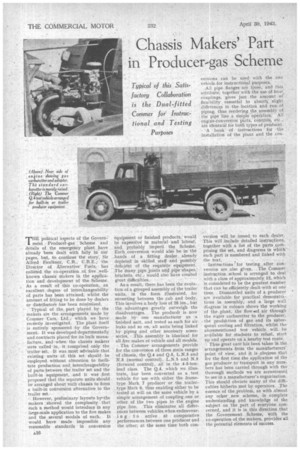Chassis Makers' Part •
Page 18

If you've noticed an error in this article please click here to report it so we can fix it.
in Producer-gas Scheme
Typical of this Satisfactory Collaboration is the Dual-fitted Commer for' Instructional and Testing Purposes
THE political aspects of the Govern.' 1 ment Producel-gas Scheme and details of the emergency plant have already 'been dealt with fully in our pages, but, to continue the story, Sir Alfred Faulkner, C.B„ C.B.E.,. the Director of Alternative Fuels, has enlisted the co-operation . of five wellknown chassis makers in the application and development of the Scheme. As a result of this co-operation, an excellent .degree of interchangeability' of parts has been attained, whilst the amount of fitting to be done by dealers or distributors has been minimized.
Typical of the part played by the makers are the arrangements. made by Commer Cars, Ltd., which we have recently investigated. The plant itself is entirely. sponsored by .the Govern., ment. It was developed :departmentally and .contracts placed for its bulk manufacture, and when the chassis makers i.vere 'called -in, it Comprised only the trailer. set, It was most advisable that existing units of this Set should be employed without alteration to facilitate production and, interchangeability of parts between the, trailer set and the built-in equipment, and it was .first proposed that the separate units should be arranged about 'each chassis to form a built-in conversion alternative to the
trailer set. . . .
• However, preliminarylayouts bysthe makers showed the complexity that such a method would introduce in any large-scale application to the five makes and the several models of each. It -would have made impossible any reasonable standards in conversion
equipment or finished products,' would he expensive in material and labour, and probably imperil the Scheme. Each conversion would also be in the hands of a fitting dealer already depleted in -skilled staff and possibly' deficient of the requisite equipment. The Many pipe joints and pipe shapes,' brackets, etc.; would also have created great difficulties.
. As:a result, there has been the evolit-. tion of a grouped assembly of the trailer units, in the form illustrated, for Mounting between the cab and body. This involves a, body loss of 28 ins., but the advantages greatly outweigh the disadvantages. The producer is now made by one manufacturer as .a finished unit, and tested as such for air leaks and so on,-all units being linked by piping and other necessary aceessories. This assembly is identical for all five makes of vehicle and all models.
The. Commer arrangements provide for the conversion of three main ranges of chassis, the Q.4 and Q.5, L.N.5 and N.5. (normal control), -L,N.5 and N.5 (forward control), all' in the 4-5-tonload class. The Q.4, which we illustrate, has been converted as a test vehicle for use with either the frametype Mark 7 producer or the trailertype Mark '6. thus enabling either to be tested at will on the same vehicle by a simple arrangement of coupling one or. other of the two pipes to the engine pipe line. This eliminates all differences between vehicles when endeavourin g to arrive at comparative performances between one producer and the other; at the same time both con
versions can be used with the . one vehicle for instructional purposes. All pipe flanges are loose, and this attribute, together with the use of hose, couplings, gives just the amount of • flexibility essential to absorla slight differences in the location and run of piping, thus rendering the assembly of the pipe line a simple operation... All engine-conversion parts, controls, etc., are identical for both types of Producer.
'A book of instructions for the installation of the Plant and the con
version will be issued to each d_ealer. This will include detailed instructions, together with a list of the parts .corii• prising the set, and diagrams in 'width each part is numbered and linked with the text.
Instructions for testing after conversion are also given. .The Commer instruction school is arranged to deal with a class of approximately 12, which is considered-to be the greatest number that can be efficiently dealt:with at one time, Dismantled units of a .producer • are available for practical demonstrations in assembly, and a 'large wall diagram in colours shows the working of the plant, the flow sof air through the water .carburetter to the producer, the prodifction of gas and its subsequent cooling and filtration, whilst the aforementioned test vehicle will be available for students to refUel, start up and operate on a nearby test route.
Thus, great' care has been taken in the arrangements from the manufacturers' point of view, and. it is •obvious that , for the first time the application of the gas producer to' transport in any numbers has been carried through with the thorough methods we are accustomed to see in a manufacturer's organization. This should obviate many of the difficulties hitherto mot by operators. The essence; of the problem, as with almost any other . new scheme, is complete understanding and knowledge of the subject on 'the . part Of everyone .con. cerned, and it is in, this direction that the Government. Scheme, with the co-operation of the makers, prbvides all the potential elements of success.




















































